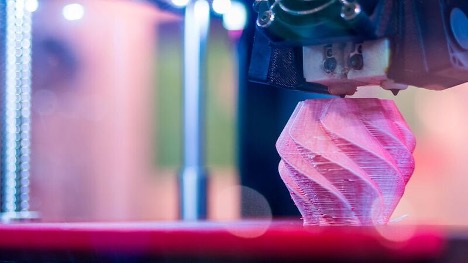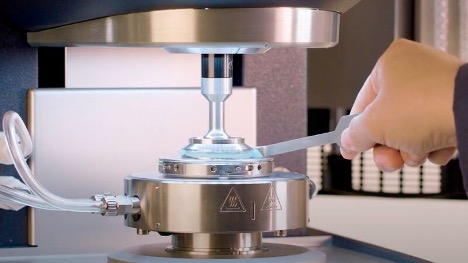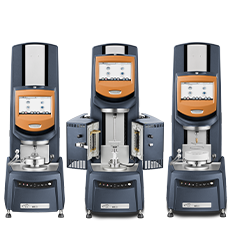How to Improve Additive Manufacturing (3D printing) with Rheology
Characterizing polymers for effective products
Morgan Ulrich | Corinna Johannisson
January 25, 2023
Successful additive manufacturing products depend upon your materials’ properties and behaviors. Rheology provides valuable information for safe, efficient, and reproducible polymer manufacturing.

Polymer products are everywhere, from packaging films and yogurt cups to complex car parts. Even across such diverse applications, plastic products are typically made with the same simple steps:
- Start with polymer-based materials, usually in the form of granules or powders
- Heat the material to make a free-flowing melt
- Shape melted material through processes such as film blowing, injection molding, extrusion, or additive manufacturing (3D printing)
- Let product cool and solidify
The resulting product’s properties and physical form is greatly dependent on its processing. Manufacturers need in-depth knowledge of their material and application to achieve their desired final product qualities. Learning about the material during processing is possible but leads to greater material losses and increased production costs.
Material characterization is more efficient and ultimately more productive when carried out on a laboratory scale prior to processing. Then, manufacturers can design processing conditions around materials’ measured properties.
Manufacturers and researchers alike utilize rheology, the study of a material’s deformation and flow. Rheology offers crucial, precise insights about both liquid and solid materials to inform successful additive manufacturing.
Quality control challenges
While additive manufacturing presents new opportunities for efficiency and unique shapes, there are various obstacles in creating a perfect product.
During additive manufacturing, the polymer is melted to a molten state and extruded through the lines and nozzle of a 3D printer. The polymer must therefore be free flowing, requiring the lowest possible viscosity. However, the polymer must retain its shape immediately after extrusion and not deform during cooling. Lukas Schwab, an application specialist at Waters – TA Instruments, notes that the material used in 3D printing requires a precise balance between viscosity, a characteristic of a liquid’s flowability, and the elasticity of a solid.
3D printing involves pressing a polymer through a narrow die. A phenomenon known as “strand expansion” can occur, whereby immediately behind the die, the diameter of the polymer strand increases slightly compared to that of the shaping die. The extent of diameter change can be examined with a rheometer. Predicting and measuring strand expansion helps manufacturers ensure the precision of their 3D printed product.
Incorporating recycled materials presents another challenge to polymer manufacturers. Used plastics often contain residue additives, colors and fillers that can affect the quality and processability of a melt as well as its behavior during manufacturing. Consequently, recycled plastics’ processing and final product can be difficult to predict. Bioplastics therefore require detailed material analysis.
Quality control in advance
Despite these potential disruptions and uncertainties, manufacturers can still perform strong anticipatory product control and quality assurance. Two angles of analytical consideration are key:
- The interaction of all material components used in the product
- The necessary processing parameters, including temperature, pressure, and flow rate
Marco Coletti, application and support specialist at Waters, explains how 3D printing and additive manufacturing processes can be optimized with the help of rheological studies in his Webinar.
Material characterization made easy
The use of correspondingly powerful, high-precision rheometers makes it possible, explains Lukas Schwab, to determine rheological properties, which is an important part of material characterization.
“Especially in the case of liquid substances such as polymer melts, however, understanding and predicting the rheological properties can be very time-consuming without adequate instrumentation,” says the application specialist from Waters. The behavior of a sample often varies depending on the magnitude of the forces acting on it, which means “the flow and deformation behavior of a sample can be only vaguely predicted experimentally, or more precisely determined by rheology.”

Key rheological measurements for 3D Printing

The Discovery Hybrid Rheometers (DHR) are versatile analysis platforms for rheology. Equipped with the latest, patented technology and extremely user-friendly, measurements with direct tension or deformation control as well as axial force specifications are made easy.
Rheological measurements are carried out with rheometers. A rheometer measures the deformation of a material (liquid or solid) when a force is applied to it. The combination of stress, deformation and shear behavior forms the basis of rheology, the science of the deformation of materials.
For rotational rheological measurements, the sample is placed in a cylinder between two round plates and pressed together. Then one of the plates is rotated, for example, with a defined speed and direction. “Rotational measurements are suitable,” explains Lukas Schwab, “to determine the viscosity of a material and thus its pumping and processing capability, for example in 3D printing.”
In contrast, oscillation measurements, whereby one of the two plates is moved back and forth in a sinusoidal manner with a small amplitude, provide more information on the equilibrium structure of the sample and are therefore used more to determine material properties. Oscillation measurements help to find answers to questions about the molecular weight of different product batches or the behavior of a material when it is exposed to low forces.
The viscosity or viscoelasticity of a material is usually determined with the help of rheometry, Lukas Schwab summarizes: “Viscosity – as a measure of the flow resistance caused by internal friction – depends on the microscopic properties of the system, such as the particle size. Viscoelasticity, in turn, is a measure of a material’s properties in response to a deforming force. In a purely elastic material there is no dissipation of energy after a load has been applied; in turn, in a viscoelastic material, there is some change in effect (hysteresis) in the stress-strain behavior due to the deformation of the material.”
Rheological measurements are used in many production processes as a means of quality control, since undesirable viscoelastic behavior can lead to poor material performance and brittleness, explains Lukas Schwab. Viscoelasticity can also be used to determine the durability and thermomechanical decomposition behavior of solids.
Measuring all the necessary properties – viscosity, molecular weight, material behavior, and viscoelasticity – may seem daunting, but the Discovery Hybrid Rheometer is uniquely capable of providing a complete picture of molten or solid polymer materials with industry-leading accuracy and ease of use.
Learn more about other kinds of material analysis for sustainable, efficient polymer production on our polymer application page. And contact TA Instruments to connect with polymer material analysis experts.
Other Resources
- Webinar – Improving Li-ion Battery Technology through Advanced Material Analysis
- Webinar – Unlock a New Dimension in your Battery Research Through Isothermal Microcalorimetry
- Webinar – Applications for Isothermal Heat Flow Calorimetry – Lithium Ion Battery Chemistry
- Webinar – Enhanced Understanding of Lithium ion Battery Chemistry Through Isothermal Calorimetry
- Application Note – Investigations into Dry Cell Battery Discharge Rates Using TAM Air
- Application Note – The Impact of Electrolyte Additives in Lithium-ion Batteries Determined Using Isothermal Microcalorimetry
- Application Note – Microcalorimetry for studying the electrolyte stability of lithium/manganese dioxide batteries







